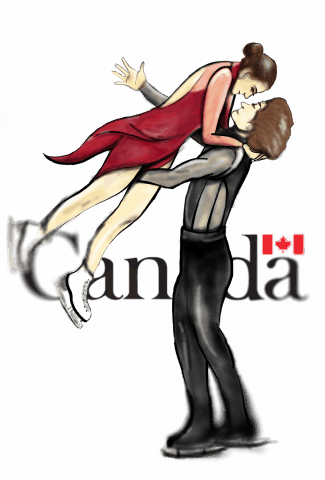Scott Moir and Tessa Virtue saved my life. Well, not really — not at all — but they make me a little more happy to live it. I can’t really explain why, but they make me feel proud to be Canadian — whatever that means.
When trying to define Canada, we’re quick to grasp for any heartwarming and seemingly unproblematic symbol — like the Tragically Hip, ketchup chips or Roll Up the Rim to Win. If we’re going to continue by this standard, allow me to make a case for the induction of Scott Moir and Tessa Virtue into the celebrated ranks of things we tout as representative of our national identity.

I wasn’t entirely set on my positive opinion until Moir and Virtue’s final performance at the 2018 Winter Olympics in Pyeongchang, South Korea. In my opinion, there was nothing more gut-wrenching — and I think this was surely felt across the nation by at least a few people — than the first chords of “Long Time Running” with the pair’s graceful, calculated and meticulously synchronized opening moves.
I don’t even really like the Tragically Hip, but I think there’s this phenomenon wherein, if you combine a number of popular Canadian elements, you get a result that prompts a sentimental response — like, for example, when the CBC took another stab at Anne of Green Gables as a broadcast series and used the song “Ahead by a Century” in its opening credits. Wait — maybe I do like the Tragically Hip.
Regardless, there are so few good things for me to cling to in this era of second-hand Trumpism, broken justice systems and food insecurity.
In 2016, professor of education and sociology Cynthia Miller-Idriss explained in an article in The New York Times that national symbols have significance because they evoke emotional attachments and crystallize identities — they help people feel connected to something beyond their immediate family and community.
Is that connection bad? I don’t think so. If we have at least a few things we can all agree to like that make us feel good about ourselves and connected to one another on some level, we can be happy, right?
I think Moir and Virtue are excellent candidates for this kind of representation. Theirs is a heartfelt, passionate and work-hard-to-get-what-you-want kind of story. They are a champion ice-dancing team, having won three Olympic gold medals — one in 2010 and two in 2018. The 2017-18 competitive season marked their 20th year as ice-dancing partners, having begun as young children in London, Ont.
They just do what they’re good at and keep the rest of their business to themselves. They’re effectively sponsored by their Canadian-ness, so they stand as national points of pride with the word Canada already stitched across their jackets. Moir and Virtue are easy to love, easy to identify with and easy to want the best for.
If we can all agree on that, then we’ve got something to start talking about — we have a commonality — and I’d like to think that, in some small way, it will bring us all closer together.
Of course, I’m a sucker for anything that makes my heart feel mushy, but the neutrality of Moir and Virtue’s essence as national symbols is also quite attractive. I only associate them with their sport, their public appeal and their fabulous matching costumes — I don’t have to think about much else with them. It’s their simplicity that will unite us, I’m sure.
—
Emily Migchels / Opinions Editor
Graphic: Jina Bae